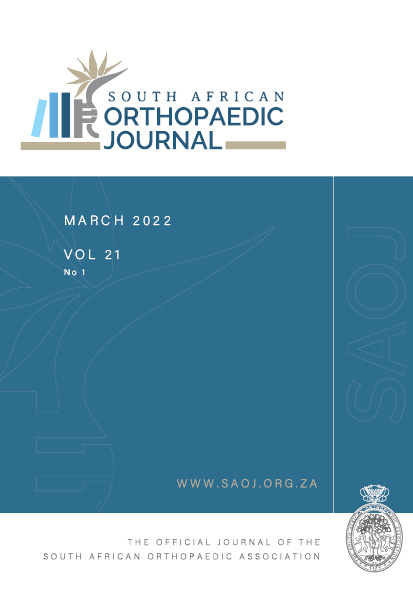Not strong enough? Movements generated during clinical examination of sagittal and rotational laxity in a cadaver knee
Keywords:
knee, anterolateral ligament, anterior drawer’s test, pivot shift, rotatory instability, anterior cruciate ligament, iliotibial band, Kaplan fibresAbstract
Background: Injury to the anterior cruciate ligament (ACL) is associated with sagittal and rotational laxity, which is exacerbated by damage to the anterolateral capsuloligamentous structures, also known as the anterolateral ligament (ALL). The amount of laxity reported in biomechanical studies might be clinically insignificant during a surgeon’s examination, possibly influencing clinical judgement. We aimed to measure whether the motion generated by clinicians in a cadaver model after the ACL and AL were transected is clinically significant.
Methods: A group of orthopaedic surgeons and trainees examined a cadaver knee for sagittal and rotational laxity at 30° and 90° with intact ligaments, after the ACL was transected, and after the ACL and ALL were transected. The examiners were blinded to the dissection process. Rotational and sagittal movements during these examinations were recorded by a computer-assisted surgery (CAS) system.
Results: Twenty-four orthopaedic surgeons took part in the study. The median sagittal plane motion captured by CAS at 30° flexion was 7 mm (IQR 2 mm, p-value 0.32) in the intact knee, 9 mm (IQR 1 mm, p-value 0.34) after the ACL was cut and 9 mm (IQR 3 mm, p-value 0.63) after ACL and ALL were cut. The median arc of rotational motion at 30° was 19° (IQR 7°, p-value 0.12) in the intact knee, 24° (IQR 5°, p-value 0.56) after the ACL was cut, and 22° (IQR 6°, p-value 0.8) after the ACL and ALL were cut. None of the differences in these movements was significant.
Conclusion: The surgeons could not generate significant differences in sagittal or rotational motion in a cadaver model, which could be objectively detected by CAS, when examining the intact knee, ACL deficient (only), or combined ACL and ALL deficient knee. This challenges the utility of known clinical tests and calls for improved objective laxity assessment tools to provide input in clinical decision-making and measure outcomes of these injuries.
Level of evidence: Level 5

